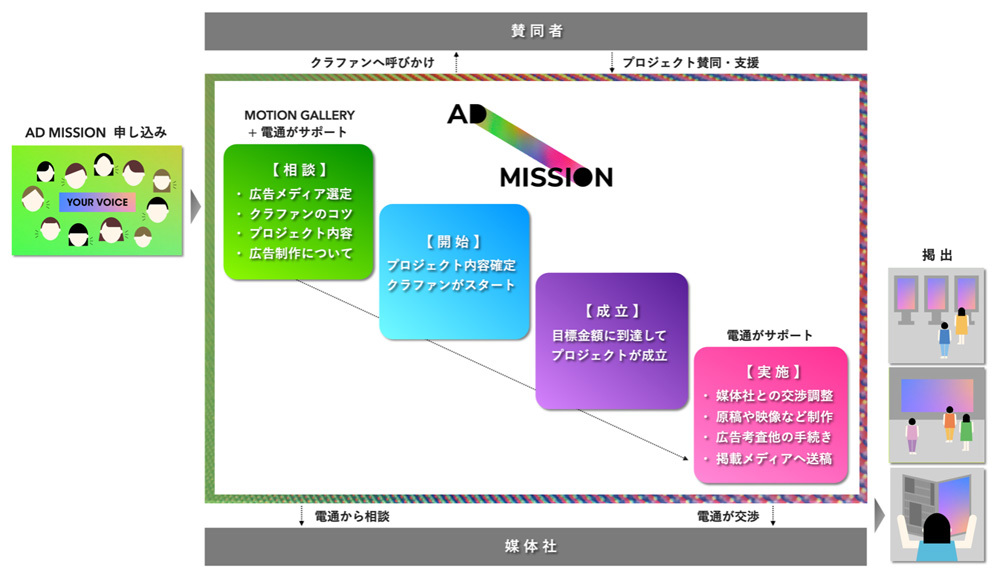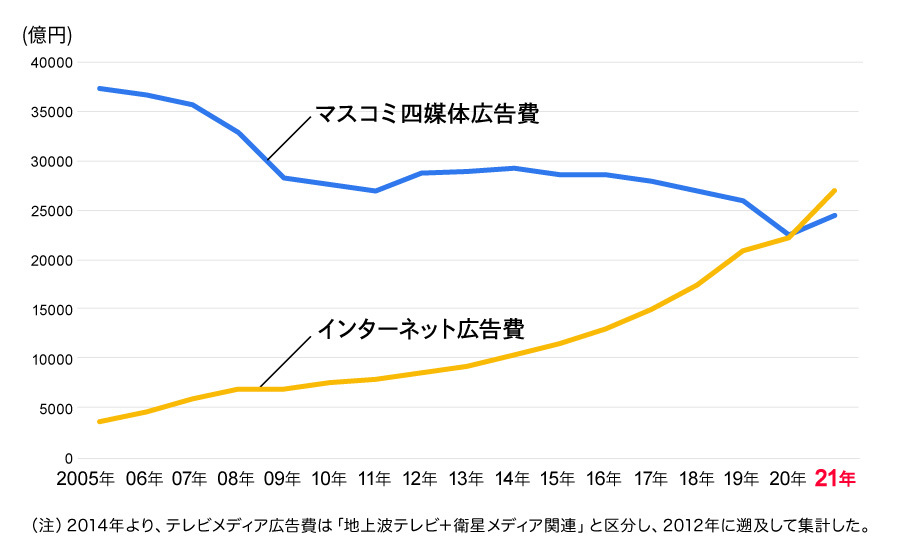"Advertising for every message you want to deliver." Launched with this vision, " AD MISSION " is a new service platform that enables anyone, even individuals, to conduct advertising communication using mass media as a medium by leveraging crowdfunding.
Last time, we introduced the service and discussed the potential of crowdfunding and the background leading to its launch.
This time, we explore the potential of "AD MISSION" from the perspective of its impact on mass media advertising.
Internet advertising is growing. Will traditional media advertising continue to decline?
"2021 Japan Advertising Expenditure" was announced on February 24, 2022.
Despite the pandemic last year, advertising spending showed an overall recovery trend, partly due to the impact of the Tokyo 2020 Olympics and Paralympics.
Particularly noteworthy was internet advertising, which reached ¥2.7052 trillion (121.4% year-on-year), surpassing the combined ¥2.4538 trillion spent on the four traditional media (hereafter "4MS") for the first time.
Looking at the trend over recent years, advertising spending on the four mass media has been steadily declining, while internet advertising spending has shown robust growth. This reflects the current situation where advertisers are said to be undergoing a "digital shift."
One factor is the broader societal trend toward digital transformation (DX) and the continuous evolution of data-driven PDCA methodologies in advertisers' marketing activities. Within this context, it's a natural progression that investment tends to gravitate toward "internet advertising," where results are most easily quantified and visualized.
However, when asked, "Has the value of the four mass media outlets disappeared?" I don't believe that's the case.
The Rise of "Oshi-katsu" and the Potential of Traditional Media Advertising
In recent years, the term "oshi-katsu" has gained traction, particularly among younger demographics, referring to immersing oneself in hobby activities like purchasing goods or attending events related to idols or anime characters. "Oshi-katsu" involves not only actively dedicating time to a particular content but also, as mentioned earlier, generously investing money through purchases and event attendance.
Pouring time and money into one's "oshi" translates to "supporting and cheering them on." And "advertising activities" are also included as one option within oshi-katsu.
For example, the term "senil ad" (senil means birthday in Korean) has recently become well-known in Japan too.
This refers to ordinary fans in Korea who support idol groups, artists, or sports figures purchasing advertising space themselves to show support for their favorite idol or artist on occasions like their birthday. They buy advertising slots for poster ads displayed in subway stations or bus stops, or for OOH (Out-of-Home) advertising like digital signage, and place their ads there.
Several examples of this phenomenon have also emerged in Japan. Fans pool their money to place ads conveying messages timed to moments like an idol or popular artist's birthday, retirement, or group disbandment.
While not traditional mass media like newspapers, OOH advertising is often chosen for these campaigns. For newspaper ads, the value lies in characteristics like non-reproducibility ("aligning the publication date with the anniversary") and a sense of exclusivity ("limited circulation means not everyone can obtain it," creating collectible appeal).
Furthermore, OOH advertising offers the appeal of being able to specify dates and times, deliver impact, and place ads "at locations connected to their favorite artist" or "where fans gather (so-called sacred sites, etc.)." The unique regional and landmark value inherent to OOH likely feels significant to fans.
As mentioned earlier, in today's increasingly digital marketing landscape, traditional mass media advertising may be falling behind internet advertising in terms of "measurable effectiveness and efficiency." However, by focusing on the unique value each medium offers and targeting new customers who seek that value, new business opportunities could emerge.
Creating a world where anyone can have their advertising needs met in one place, whenever they want
So far, as one example of output, we've explained the affinity between advertising activities and highly passionate individuals who engage in "support activities" (oshi-katsu). However, I believe such advertising outputs remain scarce in Japan.
One reason is that advertising is a B2B business, making it difficult for ordinary consumers to understand. There are barriers like finding information on how to purchase ads, researching and negotiating with the right contacts for desired ad placements, and the risk and anxiety associated with pooling large advertising budgets.
Despite this emerging customer demand for "advertising activities," participation has been slow. AD MISSION was launched to address this gap.
AD MISSION is a one-stop service that handles all foreseeable steps: crowdfunding for collection, consultation on ad space selection, purchasing on behalf of clients, and even creative production when needed. We aim to help the activities of these passionate individuals reach their output more seamlessly.

In an era of "efficiency," focusing on the "passion" that cannot be fully predicted by numbers
Beyond newspapers and OOH, radio holds value as an audio medium with personalities and programs boasting dedicated fanbases, while magazines offer cutting-edge information, networks, and loyal readers within specific fields.
By focusing on advertisers who embody consumer passion—beyond traditional B2B advertising—and building systems to enable their activities, we believe media like radio and magazines can rediscover their value and generate renewed demand.
I hope AD MISSION will lead to business transformation (BX) for media and provide new customer experiences (CX) for the individuals who use AD MISSION. I look forward to creating examples one by one and demonstrating new possibilities for advertising.





